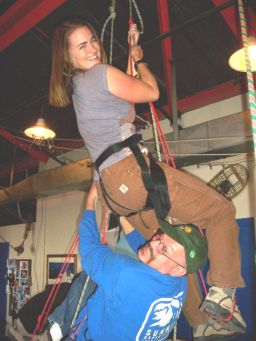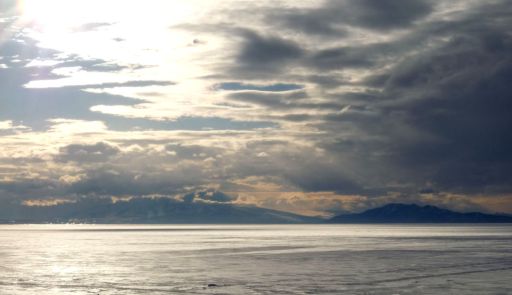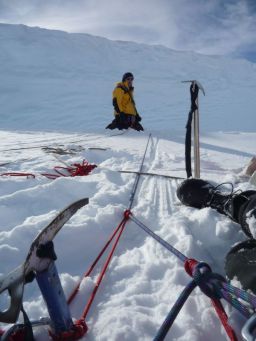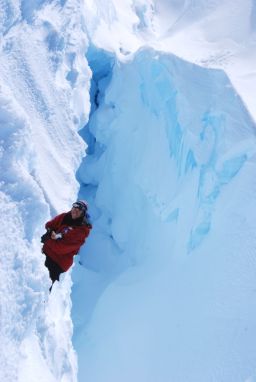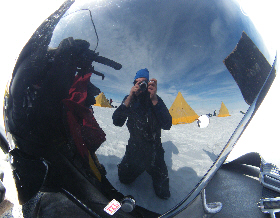ANSMET team • Dec 10, 2008
The Antarctic search for meteorites: preparations
We're in McMurdo!
December 4, 2008
A new post will follow quickly- but not to be coy about it, we left Christchurch about 9:30 or so this morning and arrived in McMurdo about 3 pm. John met us as we got off the bus from the airfield, and we've all found our rooms, been debriefed about half a dozen times, and hope to hit the ground running as our season prep hits high gear tomorrow morning.
In the Belly of the Beast
December 4, 2008
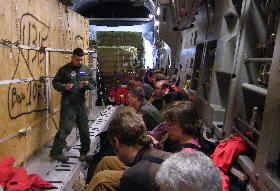
Traveling in a C-17
ANSMETToday we succeeded! We boarded the plane, and as I begin this post, we are just over two and a half hours out from Christchurch. Flying time to Antarctica on a C-17 is about 5 hours. We have passed the mid-way point where we would have turned around if the weather in McMurdo was too bad for landing.
Of course, the C-17 has a long flying range. It is possible that if a bad storm or heavy fog suddenly developed in McMurdo, we could still turn back. But I am satisfied knowing that we seem to be “good to go” all the way.
The C-17 is a big cargo plane. There are seats along the bulkheads (walls) and the center is occupied by gear. Maybe this will give you some idea of just how big this plane is: The last time I returned from Antarctica (January 2005) I came out on a C-17. The cargo area held, in addition to all of the passengers’ field gear, a complete helicopter.
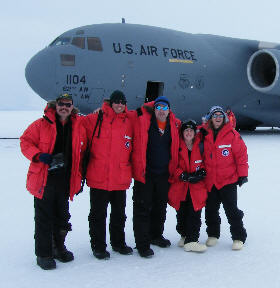
In Antarctica!
ANSMETThe plane we’re on now is stuffed with 12 pallets of carefully packed gear, equipment and supplies for us and all the other people now in Antarctica. Each pallet is about 12 feet long by 12 feet wide by 8 feet high. We humans seem to be a mere afterthought on this flight, as though after all the pallets were on board, the load master suddenly thought “Oh yeah, I’ve got to put those darn scientists somewhere.”
Actually, not everyone on board is a scientist. The passengers include support workers for McMurdo Station and South Pole Station, field support people, and military folk who run the some of the air support operations in Antarctica.
Two and a half hours later: Luck is with us, and after 5 hours in the air, we land at Pegasus Field, Antarctica. The 2008 ANSMET team has arrived!
Cheers,
Duck
We couldn't do it without a lot of support!
December 5, 2008
Getting ready to spend six or so weeks in the deep field in Antarctica is not easy. Take food for example. At home you go to the grocery store maybe once a week. And what if you forgot something? No sweat! Just hop in the family car and go get it! Where we are going, we do not have that luxury. We have to have everything we will need to eat for six weeks all packed up and ready to go before we leave for the field.

Peggy Malloy (left) tells Jani just how much chocolate she can have
ANSMETHow do we do that? Easy! We go talk to Peggy Malloy in the Berg Field Center. Peggy is in charge of the food room, and she is great at it. She has been doing this for half a dozen years, and by now, she has an innate sense of what people need - and how much - to survive in the harsh climate of Antarctica.
Today we had our preliminary talk with Peggy where she gave us some general advice on food allotments, including a long list of food items available that we will use to make our choices. Once we have made our decisions, we will go pull all the food we need and box it up for transport out to the field. We will do that early next week. And Peggy will be there to make sure we do not goof up.
Another thing that is about to become important in our lives is transport across snow and ice. For that we have Ski-Doos. These will be our “horses” out in the field. We will ride on them and carry all the gear necessary for a day of meteorite hunting. Being mechanical, we can expect some breakdowns. Out at a remote camp, it will be up to us to get them running again.
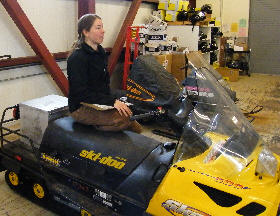
Shawntel Stapleton explains the inner secrets of our Ski-Doos
ANSMETThe fine folks in the Science Support Center (SSC) help us with this. Today we got a general introduction to the Ski-Doos we will use, descriptions of some of the more likely problems we could have, and instruction on how to fix them. This information was imparted by Shawntel Stapleton. While this is only her first year in the SSC, she certainly knows her stuff. She showed us what to pay attention to to try to avoid breakdowns, and she had us getting our hands dirty swapping out belts and sparkplugs.
The best part was the Ski-Doo try-outs on the sea ice. Shawntel had us running a course over snow and ice to give us a feel for our “horses.” This year, four of the six people on the team have considerable experience Ski-Dooing in Antarctica, but two are new at it. This try-out gave them a chance to see how the machines handle, before we go out on much longer trips.
We still have much to do before we will be ready to go out to the field, but we are making progress.
Cheers,
Duck
Survival School
December 8, 2008
One of the most important things we do while in McMurdo is train for our expedition on the polar plateau. More specifically, we spend a day in the classroom discussing the potential hazards and the ways we can minimize them. This is followed by a two day "shakedown" trip, an overnight journey out onto the Ross Ice Shelf that puts our newfound knowledge to a few tests and lets us work our any kinks in our gear. We did our classroom work today, which included a little practical ropework inside the Berg Field Center; but we all know that tying knots and climbing ropes indoors and for fun is a lot easier than outdoors in an emergency.
The shakedown will start right after breakfast tomorrow morning. We'll take our most critical safety gear (tents, stoves, radios, sleepkits, and snowmobiles) out for a spin. We'll spend an hour or so in the morning tying all this stuff onto sleds and snowmobiles, and then travel caravan-style about 5-6 miles out of McMurdo. We'll practice setting up camp, walking safely among crevasses (all roped together), driving snowmobiles under different conditions, and finally practice a simulated crevasse rescue a few times. Of course we really don't want to have to use these skills, but even a little practice can provide a lot of confidence should an emergency occur. More practically, if there's something wrong with a tent or a snowmobile, it's a lot nicer to find that out 5 miles from McMurdo rather than 500 miles from McMurdo.
Finally, a picture of the Midnight Sun taken last night by Deon. Over the past few days the sky has been pretty grey, the wind brisk and the air cold. But this afternoon it's been very warm, pushing above freezing, and the overcast has broken up and yielded to a deep blue sky. We're expecting some great weather on our shakedown, which may not be a realistic simulation of the polar plateau where we're going, but sure makes the learning experience more fun.
- from Ralph.
P.S. Hi Tuck, Eli, and Westwood Elementary!
Movers and Shakers
December 8, 2008
A weekend campout takes on a whole new meaning when you add huge quantities of snow, glacial ice, and a looming volcano, and subtract all the crowds. And it’s really hard to beat Ski-Dooing to your camp location across the vast, flat expanse of the ice shelf off McMurdo and Scott Base. This weekend was our shakedown, or gear test and crevasse rescue and snow safety training. We think of this part of our trip as a real bonus, as we get to partake of a portion of the many years of training and experience of mountaineer Johnny Schutt. We prepare for all kinds of scenarios that may occur out on the ice, from minor frost nip to hunger to more severe issues such as a Ski-Doo accident or fall into a crevasse, or vertical crack in the ice. These can be wide enough to swallow a few Ski-Doos and deep enough that you’d never see daylight again. Although we don’t typically work near crevasses, it’s good to be prepared just in case.
We roped up together, mountain climb style, and marched off toward certain crevasses. Johnny didn’t disappoint with his yearly tradition of flinging himself off into a crevasse, letting the two roped to him overcome their panic and self-arrest to save themselves and John. Deon said the visual came close to Bilbo Baggins’ birthday party disappearing act from Fellowship of the Ring. We all did our best to learn and repeat 2:1, 3:1, and 6:1 pulleys for hauling each other out of the gaping, deep, lovely, blue and white crevasses.
Also, we got to test our big, yellow Scott tents and winter sleeping gear. It’s hard to convey just how cozy you can feel nestled deep in those big sleeping bags with the soft yellow light of the tent coaxing you toward oblivion. Huge, snowy Mount Erebus, with its smoking summit lava lake, provided a campsite backdrop we dare you to try to top -- see the movie by Johnny Schutt (Quicktime format, 650k).
(Here's a little shout out to our fans at JSC...glad you like the show).
- Jani Radebaugh
Still on track
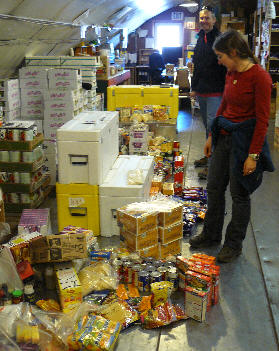
Amy wonders how she'll ever eat all that food.
ANSMET
Penguin tracks in the snow.
ANSMET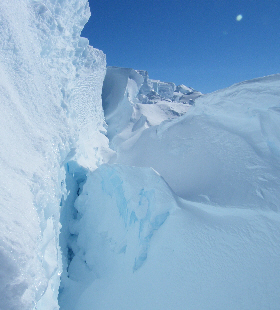
Ice wall.
ANSMETDecember 9, 2008
Today was a busy day for us. In the morning we got most of the gear problems we identified during the shakedown trip sorted out. For example, my sleeping bag was long enough, but too narrow. I could fit in it, but not with my teddy bear. OK, I don’t actually sleep with a teddy bear, but I do sleep with a set of thermal underwear tops and bottoms and wool socks. I want them nice and warm when I put them on in the morning. There are few things in life more unpleasant than putting on ice cold clothes first thing in the morning. It is, on the other hand, an excellent way to come fully awake in an instant.
In the afternoon we visited our friend Peggy Malloy in the food room. It was time for phase one of the food pull. We spent about three hours collecting dry goods, canned food, spices and such that we will need to eat for six or more weeks. The process is a little like looting a supermarket. Earlier Peggy had given us lists of the items available, and we went through the lists deciding what and how much to take. Today each tent pair went up and down the aisles, pulled off what we wanted, and put it in a pile in the food room. When we declared that we were done Peggy came and scanned all the items to keep a log of what we had taken.
All the food was then packed into boxes and weighed. Deon and I took 300 pounds of food. So far. Tomorrow we pull the frozen foods.
The food and all our gear got put into three large wooden boxes that will ultimately be weighed and loaded onto the planes that will take us out to the field. We are nearly there. Tomorrow after we get the frozen food all of our expedition equipment should be in the cargo stream.
Oh, and Cecilia, I did take plenty of the special item that you recommended I should take.
I’d like to leave you with a couple of pictures I took during the shakedown trip. On our way out to our camp site we came across some fresh penguin tracks. He or she was going the same way we were, but we never did see the critter. The other picture I took looking along the ice wall while I was dangling in the crevasse waiting to be “rescued.” I was suspended maybe 80 feet above the visible floor of the crevasse.
Cheers,
Duck
Tomatoes in Antarctica?
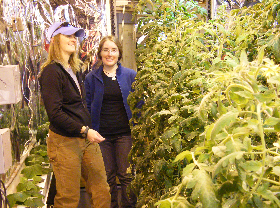
Amy and Jani admire the tomato crop
ANSMET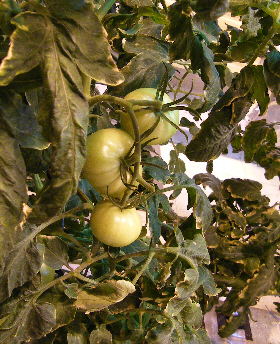
Antarctic brand tomatoes
ANSMETDecember 10, 2008
Today we pulled our frozen food, got it boxed up and into the cargo stream. Now, all of our gear is being processed by the cargo folks in preparation for loading it onto a plane for delivery to the field. Basically, we are all set to go. We are now at that stage of an expedition where we have little to do but wait for our turn for flights out to the field.
Jani, Amy and I filled part of that time with a visit to the greenhouse they have here in McMurdo. It is really funny to see green, growing plants in Antarctica, even if they are in a greenhouse. It is just not something you expect to see! The tomato crop seems to be doing just fine, and the flowers are lovely. It is a nice touch that makes life in this remote place a little bit more pleasant. I definitely plan to visit the greenhouse when we return from the field just to remind myself what plants look like. They have a slang term here: “greenout.” It is the feeling a long-term Antarctic resident gets when he or she finally goes northbound to New Zealand, and is suddenly confronted with an endless expanse of green plants. Maybe a trip to the greenhouse will lessen my feeling of greenout when I go north?
Our plans? John Schutt and I are listed for a Twin Otter flight for Friday, but are alternates on tomorrow’s flight. (A Twin Otter is a small, twin-engine airplane that can be fitted with skis to land on the snow.) The plan is that John and I will go out first with equipment to flatten out the snow for the larger plane that will bring in the rest of the field team a few days later. Basically, we will be making a snow runway out on the Polar Plateau. The ironic thing about this is that during the Great Depression when jobs were hard to find, my grandfather was paid by the government to shovel snow at the Buffalo Airport. I guess snow removal at airports is a job that runs in my family!
Finally, I’d like to leave you with a picture I took on our shakedown trip. One thing different this year is that we are required to wear helmets while riding ski-doos. They are black, shiny and very reflective. I call this picture “Duck, his Tent and Ski-Doo; a self portrait in Ski-Doo Helmet.”
Cheers,
Duck
Support our core enterprises
Your support powers our mission to explore worlds, find life, and defend Earth. You make all the difference when you make a gift. Give today!
Donate

 Explore Worlds
Explore Worlds Find Life
Find Life Defend Earth
Defend Earth


